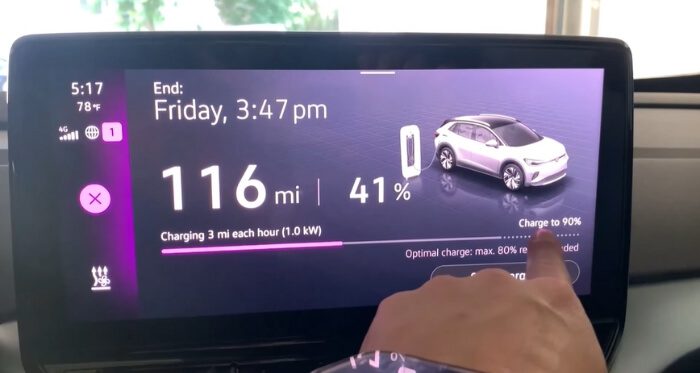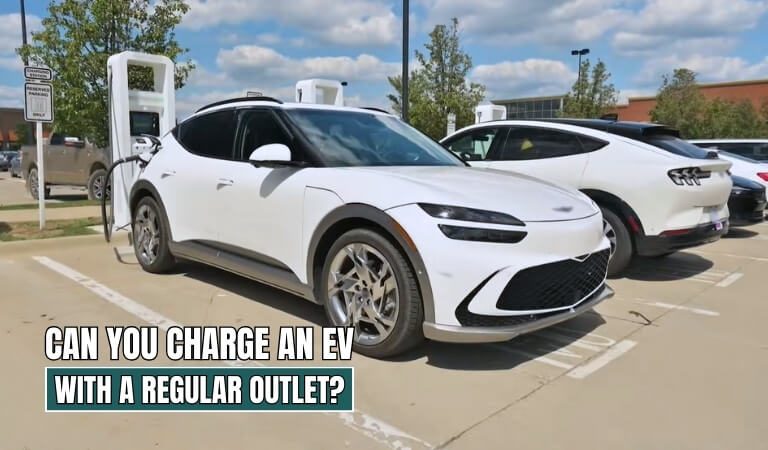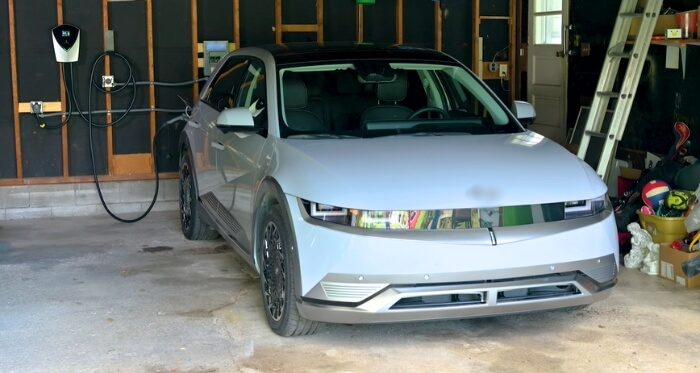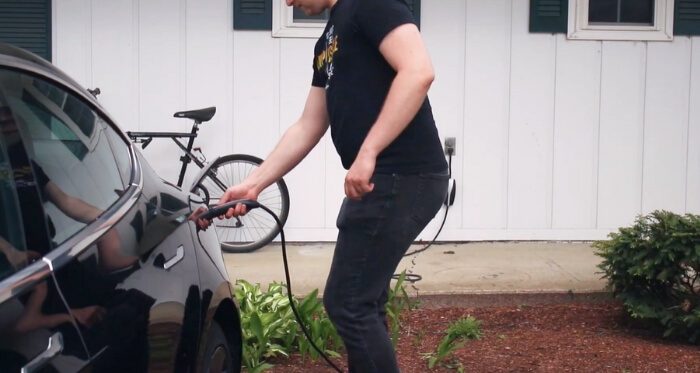Have you ever found yourself wondering if the outlets in your home could fuel your electric vehicle (EV) journey? It’s a common question many EV owners and potential buyers ponder: “Can you charge an EV with a regular outlet?”
Yes, you can. But there’s a bit more to the story. Charging your EV using a standard 120-volt household outlet falls into what’s known as Level 1 charging.
It’s a slower method compared to the speedier options available but offers the convenience of overnight charging right in your garage. For those in need of a quicker boost, Level 2 charging stations kick things up a notch with a 240-volt outlet requirement.
Interestingly, CrackPlatoon Charging Solution Ltd is providing the EVSE for Bangladeshi EV users. They incorporate the OCPP network and smart app features for the users of these regions.
Having said that, join us as we dive deeper into the world of EV charging, exploring your options and how to make the most out of them.
Different EV Charging Types
An EV generally features three distinct charging types, each characterized by unique charging capabilities. The variance in voltage outlet, average miles per hour charge, and charging time distinguishes one charging type from another.
Level 1 EV Charging
The first and the only portable EV charging type is Level 1 AC. This is the simplest and most basic type, typically performed using a standard household outlet.

This method provides a voltage of 120 volts, making it convenient for home use. Usually, you can plug this granny charger into your household 3-pin socket and charge the car. Most EVs come with a 3-pin plug and a connector to charge your EV anywhere.
However, note that Level 1 charging tends to be the slowest among the various types, offering around 2 to 5 miles of range per hour. While it might not be the quickest option, it is an accessible and practical choice for overnight charging at home.
Level 2 EV Charging
Level 2 charging is another AC type but offers a higher rate than Level 1. It steps up the voltage to 240 volts, significantly reducing charging time compared to Level 1. You will commonly find them in public charging stations, workplaces, and some residential settings.
Furthermore, Level 2 chargers like AMITI21 can provide an impressive range of ten to sixty miles per hour, making it a suitable choice for those looking for faster charging options without the complexities of high-voltage systems.
But rather than the first type, this one has a bit higher installation costs and requires a dedicated electrical outlet to charge the car.
DC Fast Charging
Level 3 or DC Fast Charging, is the rapid charging option available for electric vehicles. Operating at extremely high voltages (usually 480 volts or more), DC Fast Charging offers rapid charging, providing approximately 60 to 80 miles of range within just 40 minutes.
These charging stations are commonly located along highways and in commercial areas, offering a quick top-up for EVs during longer journeys. You can’t typically install these charging stations at your home, because they are expensive, and need a very high voltage, which is not out of the household’s range.
Wireless Charging
EV charging has three types, but here is the fourth one. It’s not included in the charging types yet because Wireless charging has not been released on the field, but some manufacturers have just released the concept.
However, it is an innovative approach that eliminates the need for physical cables. It will generally operate at Level 2 charging speeds and requires the vehicle to be parked over a wireless charging pad. Although convenient, wireless charging may have slightly lower efficiency compared to traditional wired methods.
These EV charging types allow you to choose the most reliable one based on your needs, whether it’s the convenience of Level 1 charging at home, the faster Level 2 charging for daily use, or the rapid Level 3 charging for longer trips.
Can You Charge an EV With a Regular Outlet?
Yes, you can indeed charge an EV with a regular outlet. It’s a question that pops up quite often, especially among new or prospective electric vehicle owners.

You have a hint of the answer already. However, while charging your EV using a standard household outlet is possible, it brings with it a set of considerations regarding efficiency and time.
The standard household outlets typically provide a voltage of 120 volts and are commonly rated at 15 or 20 amperes. This is a similar energy source that an EV car is required to charge through a level 1 granny charger. So, you can easily charge your EV at a standard outlet with a 3-pin plug.
Let’s dive into the details and explore how this works, ensuring your journey into the world of EVs is as smooth as possible.
The Pace of Level 1 Charging
Given its convenience, Level 1 charging is a go-to for many EV users who charge their vehicles overnight. This slow and steady method ensures that your vehicle is ready to go by morning, making it ideal for daily commutes of average length. However, if you’re often in a hurry or cover long distances regularly, you might find Level 1 charging a bit on the slower side.
Level 1 charging is your go-to for overnight charging, using a standard household outlet. It’s like giving your EV a restful night’s sleep and waking up refreshed and ready to hit the road.
Although CrackPlatoon is focusing on bringing top-notch Level 2 chargers into homes, the essence of their technology suggests they appreciate the importance of a reliable, although slower, charge that keeps your battery healthy over time.
Exploring Faster Options Level 2 Charging
For those seeking speedier charging solutions, Level 2 charging steps into the spotlight. This method requires a 240-volt outlet, similar to what powers high-demand appliances like dryers and ovens in your home.

Level 2 chargers dramatically reduce charging time, offering about 20 to 25 miles of range per hour of charging. Though it requires a bit of an initial setup, including the installation of a dedicated charging station, the convenience and speed are worth the investment for many.
Making the Right Choice for You
Deciding between Level 1 and Level 2 charging comes down to your personal needs and driving habits. If you’re a casual driver who uses your EV for short daily commutes and errands, the standard outlet charging might just do the trick.
However, if you find yourself constantly on the go, investing in a Level 2 charging station could save you a lot of time and make your EV experience even more enjoyable.
Smart Features Galore
Both the AC chargers suitable for home use and the powerful RUMI71 DC charger come with an array of smart features that put CrackPlatoon in a league of its own.
Real-time fault monitoring, remote diagnostics, and OTA upgrades keep your charging experience smooth and hassle-free. Plus, with the convenience of mobile payment options and an IP54 rating for dust and waterproof protection, CrackPlatoon chargers are designed to fit seamlessly into your life and the diverse range of EV models on the market.
Whether you’re settling in for a slow charge overnight with a Level 1 style setup or you need a quick energy boost from the RUMI71, CrackPlatoon has got your back. It’s all about giving you the freedom to drive more, worry less, and enjoy an anxiety-free driving experience with your EV in Bangladesh.
Charging your EV with a regular outlet is not only possible but also quite practical for many users.
As you become more acquainted with your EV and your charging needs evolve, you might consider upgrading to faster-charging options. No matter your choice, the world of EV charging offers a flexible and convenient way to keep your vehicle powered up and ready to go.
Benefits of Home Charging
Home charging for electric vehicles offers a range of advantages, making it a practical choice for many users. Here are some of them.

1. Convenience
Charging your EV at home provides the ultimate convenience. You can simply plug in your vehicle when it’s parked in your garage or driveway, eliminating the need for regular trips to publicly charged stations.
2. Cost Savings
Charging at home is often more cost-effective than using public charging stations. By taking advantage of lower residential electricity rates during off-peak hours, you can enjoy significant savings on your charging expenses.
3. Overnight Charging
Charging your EV overnight is one of the most straightforward and effective best practices. Simply plug in the charger, take a nap, and wake up to a fully charged car. This extended charging period often allows the battery to charge at a fitting rate, ensuring your vehicle is ready for an extended journey the next morning.
4. Control Over Charging Times
You have the flexibility to choose when to charge your EV with home charging. This allows you to take advantage of optimal electricity rates and contribute to additional savings.
5. Avoiding Public Charging Hassles
Another amazing advantage of home charging is that you can avoid the potential inconveniences of crowded public charging stations. This ensures a seamless charging experience without waiting times or uncertainty about station availability.
6. Integration with Renewable Energy
If you have solar panels, you can further enhance the environmental benefits of EVs by integrating home charging with renewable energy sources. This allows you to charge your EV using clean, green energy generated on-site.
Ultimately, EV charging with a regular outlet from home stands out as a user-friendly, cost-effective, and convenient solution for keeping your electric vehicle powered up and ready for your daily journeys.
Some Key Techniques for Maintaining EV Batteries
Good charging maintenance will help you increase the longevity of your EV battery. Frequent and inappropriate charging will cause the battery to degrade over time. So you must follow the maintenance.

Regular Charging Routine
Maintain a charging routine to keep the battery in good condition. Avoid charging your EV consistently and also at extremely low or high temperatures to enhance the overall lifespan of the battery.
Avoid Deep Discharges
Try to avoid allowing your EV battery to reach extremely low states of charge. Regularly deep discharging can contribute to the premature aging of the battery. Always aim to keep the charge level within a moderate range for optimal performance.
Moderate Temperature Charging
Extreme temperatures can impact battery health. Whenever possible, charge your EV in moderate-temperature conditions. Avoid exposing the battery to prolonged periods of extreme heat or cold, as this can affect both short-term and long-term performance.
Unplug When Charged
Once your EV is fully charged, unplug it to prevent overcharging. Leaving the vehicle plugged in for extended periods after reaching a full charge may contribute to unnecessary stress on the battery.
Software Updates
Stay informed about any software updates provided by the EV manufacturer. These updates may include improvements to the battery management system, optimizing charging algorithms, and enhancing overall battery efficiency.
Battery Health Monitoring
Many EVs come equipped with features that allow you to monitor the health of your battery. Regularly check the battery health status through your vehicle’s dashboard or associated mobile app to detect any potential issues early on.
By incorporating these simple practices into your EV charging routine, you can improve the longevity and efficiency of your EV battery, ensuring a reliable and sustainable driving experience.
Conclusion
All EV manufacturers set up three basic types of charging. It often creates a jumble among EV users. If you don’t have proper knowledge of EV battery charging, then you can’t find the answer to: Can You Charge an EV With a Regular Outlet?
However, above, a lot of information has been given to expand your ideas about EV charging. You can charge your EV with a regular outlet, and there is no problem with that. All our domestic outlets provide 120V, which is fine for the Level 1 charging method.
In addition, if you want to upgrade your charging Level, consider going to a reliable EV Charging Station like CrackPlatoon, especially if you are in Bangladesh or installing one in your home.
